Schweiz |
|
|
|
| Übersicht – Contents: | |
Diese Seite ist Teil des Projektes
Schweiz |
|
|
|
| Übersicht – Contents: | |
Flaggen – Flags: |
|
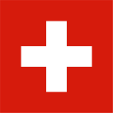 |
Nationalflagge – national flag, Seitenverhältnis – ratio = 1:1, Quelle/Source, nach/by: Flags of the World   |
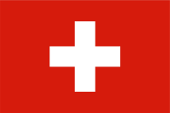 |
Handelsflagge – merchant flag, Seitenverhältnis – ratio = 2:3, Quelle/Source, nach/by: Flags of the World   |
historische Flaggen – historical Flags: |
|
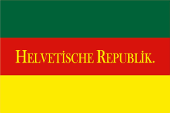 |
1798–1803, Nationalflagge in deutschen Kantonen mit der Inschrift "Helvetische Republik" – national flag in German cantons Quelle/Source, nach by: Flags of the World, Die Welt der Flaggen |
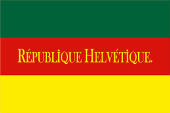 |
1798–1803, Nationalflagge in französischen Kantonen mit der Inschrift "Republique Helvetique" – national flag in French cantons Quelle/Source, nach by: Flags of the World, Die Welt der Flaggen |
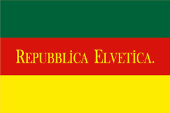 |
1798–1803, Nationalflagge in italienischen Kantonen mit der Inschrift "Repubblica Elvetica (Helvetica)" – national flag in Italian cantons Quelle/Source, nach by: Flags of the World, Die Welt der Flaggen |
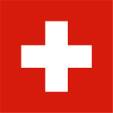 |
1840–1889, Nationalflagge – national flag Quelle/Source, nach by: Wikipedia (DE) |
| Die Flagge der Schweiz zeigt ein weißes, schwebende Kreuz (ein Kreuz, dessen Arme die Ränder des Schildes oder der Flagge nicht erreichen) auf rotem Grund. Die Arme des Kreuzes sind 6 Teile lang und 5 Teile breit. Die Breite des Kreuzes im Verhältnis zur Breite der Flagge beträgt 2/3 bis 7/10. Der Farbton des Rot in Flagge und Wappen war bis 2017 nicht per Gesetz geregelt. Es wurden verschiedene Rottöne verwendet, so etwa Pantone 032. Im Jahre 2007 schuf die Bundesverwaltung ein Corporate Design, das Pantone 485 festlegte. 2013 folgte der Beschluss des "Bundesgesetzes über den Schutz des Schweizerwappens und anderer öffentlicher Zeichen", das 2017 in Kraft getreten ist. Auch hier wurde Pantone 485 festgelegt. |
The flag of Switzerland shows a white floating cross (a cross whose arms do not reach the edges of the shield or flag) on a red background.
The arms of the cross are 6 parts long and 5 parts wide. The width of the
cross in proportion to the width of the flag is 2/3 to 7/10. The shade of red in the flag and in the coat of arms was not regulated by law until 2017. Various shades of red were used, such as Pantone 032. In 2007, the Federal Administration created a corporate design that specified Pantone 485. This was followed in 2013 by the adoption of the "Federal Law on the Protection of the Swiss Coat of Arms and Other Public Signs", which came into force in 2017. Here, too, Pantone 485 was specified. |
| Das weiße, schwebende Kreuz (ein Kreuz, dessen Arme die Ränder des Schildes oder der Flagge nicht erreichen) auf rotem Grund wurde erstmals in der Schlacht von Laupen (1339) erwähnt, und zwar als Feldzeichen des eidgenössischen Heeres. Im Jahr 1480 wurde es offiziell als Symbol der Konföderation eingeführt. | The white, free-standing cross (a cross its arms do not reach the border of the shield or of the flag) on red ground was mentioned for the first time in the Battle of Laupen (1339), namely as field-sign of the confederal army. In the year 1480 it was officially introduced as the symbol of the confederacy. |
| Nach dem Einmarsch der französischen Truppen unter Napoléon wurde die Schweiz "Helvetische Republik", ein französisches Protektorat. Am 13.02.1799 wurde als eine erste gemeinsame Schweizer Flagge eine dreifarbige Flagge angenommen. Sie zeigte drei waagerechte Streifen in Grün, Rot und Gold. In der Mitte des roten Streifens stand der Name des Landes in großen, goldenen Buchstaben, und zwar in Deutsch, oder Französisch oder Italienisch, je nach dem in welchem Kanton sie gehisst wurde, und welche Sprache dort die vorherrschende war. | After the
invasion of French troops under Napoléon Switzerland became the "Helvetian
Republic", a French protectorate. On 13th of February in 1799, a tricolour
flag was adopted as a first common Swiss flag. It showed three horizontal stipes in green, red and gold. In the middle of the red stripe was placed the name of the country in big, golden letters, namely in German, or French or Italian, ever in which canton it was hoisted and which language there was the predominant. |
| Die heutige quadratische Flagge wurde 1840 geschaffen und im Jahre 1848 anlässlich der Verkündigung einer neuen Verfassung nach dem "Sonderbundkrieg" offiziell eingeführt. Mit dem Bundesbeschluss vom 12.12.1889 wurde die Form des Kreuzes ein wenig verändert, auf die heutige Form. | The today’s square flag was created in 1840 and officially introduced in 1848 on the occasion of the proclamation of a new constitution after the "Special-Confederation War". With the Federal Decree of the 12th of December in 1889, the shape of the cross was changed slightly to its present form. |
Zum
Ursprung der Schweizer Flagge gibt es zwei Erklärungen:
|
About the
origin of the Swiss flag exist two explanations:
|
| Die Kantone hatten und haben eigene Wappen und Flaggen. Vereinzelt trugen und tragen deren Flaggen ein weißes Kreuz als Zeichen der Zugehörigkeit zur Eidgenossenschaft. In früheren Tagen wurde dazu auch ein roter Wimpel mit weißem Kreuz über der Kantonsflagge gehisst. Die Kantonsflaggen sind oft Wappenflaggen, es gibt aber auch Flaggen, die nur die Kantonsfarben zeigen. | The cantons had and have own coats of arms and flags. Sometimes their flags carryed and carry a white cross as a sign of affiliation to the confederation. In former days was therefore additionally hoisted a red pennant with a white cross above the flag of the canton. The flags of the cantons are often scutcheon flags, but there are even flags which show only the colours of the canton. |
| Die Schweizer haben eine hervorragende Tradition als Söldner in fremden Armeen. Noch heute hat der Vatikanstaat eine Garde aus Schweizer Söldnern. Die Truppenfahnen der Schweizer Söldner zeigten oft ein weißes bis zum Rand der Flagge reichendes Kreuz und oder waren "geflammt". | The Swiss
have an outstanding tradition as mercenaries in foreign armies. Until today
the Vatican has a gard of Swiss mercenaries. The flags of the Swiss
mercenaries showed oftenly an until the border of the flag reaching white
cross and or were "flamed". |
| Quelle/Source: Flaggen Wappen Hymnen, Die Welt der Flaggen, Flaggen-Atlas Erde, Wikipedia (DE), Volker Preuß | |
Wappen – Coat of Arms: |
|
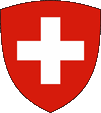 |
Wappen der Schweiz – coat of arms of Switzerland, Quelle/Source, nach/by: Flaggen und Wappen der Welt |
| Das Staatswappen der Schweiz wurde in seinem heutigen Erscheinungsbild im Jahre 1889 offiziell eingeführt. Es zeigt ein schwebendes silbernes Kreuz auf einem rotem Wappenschild. Ein schwebendes Kreuz ist ein Kreuz, dessen Arme die Ränder des Schildes oder der Flagge nicht erreichen. Dieses Kreuz wurde erstmals in der Schlacht von Laupen (1339) erwähnt, und zwar als Feldzeichen des eidgenössischen Heeres. Die Arme des Kreuzes sind 6 Teile lang und 5 Teile breit. | The coat
of arms of Switzerland was officially introduced in its today’s appearance
in the year 1889. It shows a free-standing silvery cross on a red blazon. A
free-standing
cross is a cross its arms do not reach the borders of the shield or the
flag. This cross was mentioned for the first time in the Battle of Laupen
(1339), namely as a field-sign of the confederal army. The arms of the cross
are 6 parts long and 5 parts wide. |
| Der Farbton des Rot in Flagge und Wappen war bis 2017 nicht per Gesetz geregelt. Es wurden verschiedene Rottöne verwendet, so etwa Pantone 032. Im Jahre 2007 schuf die Bundesverwaltung ein Corporate Design, das Pantone 485 festlegte. 2013 folgte der Beschluss des "Bundesgesetzes über den Schutz des Schweizerwappens und anderer öffentlicher Zeichen", das 2017 in Kraft getreten ist. Auch hier wurde Pantone 485 festgelegt. | The shade of red in the flag and in the coat of arms was not regulated by law until 2017. Various shades of red were used, such as Pantone 032. In 2007, the Federal Administration created a corporate design that specified Pantone 485. This was followed in 2013 by the adoption of the "Federal Law on the Protection of the Swiss Coat of Arms and Other Public Signs", which came into force in 2017. Here, too, Pantone 485 was specified. |
| Quelle/Source: Die Welt der Flaggen, Wikipedia (DE), Volker Preuß | |
Flugzeugkokarde – aircraft roundel: |
|
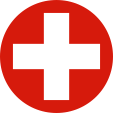 |
Flugzeugkokarde – aircraft roundel Quelle/Source, nach/by: Wikipedia (EN) |
Landkarte – Map: |
Lage – Position: |
Landkarte des Landes – Map of the Country: |
| Zahlen und Fakten – Numbers and Facts: | |
|
|
|
|
|
|
|
|
|
|
|
|
|
|
|
|
|
|
| Quelle/Source: Volker Preuß | |
| 100
v.Chr. · der keltische Stamm der Helvetier wandert in die Region zwischen
Jura-Gebirge und Alpen ein (heutiger Nordwesten der Schweiz), in den
östlichen Alpen leben die Rätier, ein Volk unbekannter Herkunft (Semiten?) 58 v.Chr. · das Gebiet der Helvetier wird vom Römischen Reich erobert und der Provinz Germania Superior (=Obergermanien) angegliedert 15 v.Chr. · das Gebiet der Alpen-Rätier wird vom Römischen Reich erobert und der Provinz Raetia angegliedert 260–270 n.Chr. · der germanische Stamm der Alemannen dringt in das Gebiet der Helvetier ein (Germanisierung) 395 · bei der Teilung des Römischen Reiches kommt die heutige Schweiz an das Weströmische Reich 443 · die Reste des von den Hunnen vernichteten germanischen Stammes der Burgunder lassen sich südlich des Genfer Sees nieder (Savoyen) und gründen das Burgunderreich 445 · der germanische Stamm der Burgunder dringt von Westen teilweise in das alemannische Helvetien ein und erobert das gesamte Gebiet der heutigen Schweiz, außer Rätien 532–534 · das Burgunderreich wird vom Frankenreich erobert und unterworfen 843 · Vertrag von Verdun, bei der Teilung des Frankenreiches kommt Helvetien an das Reich Lothars, Rätien kommt an das Reich Ludwigs des Deutschen 870 · Vertrag von Meersen, Aufteilung des Reiches von Lothar, auch Helvetien kommt an das Reich Ludwigs des Deutschen 880 · Vertrag von Ribemont, Bildung des Königreiches Hochburgund, Helvetien kommt an Hochburgund, Rätien kommt an das Ostfränkische Königreich (Deutsches Reich) 933 · Hochburgund und Niederburgund vereinigen sich zum Königreich Burgund (Arelat) 1032 · der deutsche Kaiser Konrad II. aus dem Haus der Salier erbt Burgund, Burgund kommt zum Deutschen Reich, damit gehören Helvetien und Rätien (die heutige Schweiz) zum Deutschen Reich 12./13. Jahrhundert · Bildung der Bistümer Genf, Lausanne, Sitten, Basel, Chur und Konstanz, einzelner Grafschaften unter der Herrschaft der Zähringer, später der Savoyer und Habsburger, freier Landgemeinden wie Uri und Schwyz sowie freier Reichsstädte wie z.B. Basel 1291 · „Ewiger Bund“ (Eidgenossenschaft) der drei Urkantone Uri, Schwyz und Unterwalden gegen Herrschaftsbestrebungen der Habsburger 1315 · Schlacht von Morgarten, Sieg der Eidgenossenschaft gegen ein Heer Herzog Leopolds I. von Österreich 1332 · Luzern schließt sich der Eidgenossenschaft an 1351 · Zürich schließt sich der Eidgenossenschaft an 1352 · Glarus und Zug schließen sich der Eidgenossenschaft an 1353 · Bern schließt sich der Eidgenossenschaft an 1386 · Schlacht von Sempach, Sieg der Eidgenossenschaft über die Habsburger 1388 · Schlacht von Näfels, Sieg der Eidgenossenschaft über die Habsburger 1389 · das Haus Habsburg erkennt die Unabhängigkeit der Eidgenossenschaft an 1415 · die Eidgenossenschaft erobert den Aargau und gliedert ihn als Untertanenland der Eidgenossenschaft an 1416 · Wallis schließt sich der Eidgenossenschaft an 1439 · die Habsburger werden die Deutschen Kaiser 1460 · die Eidgenossenschaft erobert den Thurgau und gliedert ihn als Untertanenland der Eidgenossenschaft an 1476 · Schlachten von Grandson und Murten, Abwehr von Expansionsversuchen Burgunds 1481 · die Stadtkantone Freiburg und Solothurn werden als Untertanenländer der Eidgenossenschaft angeschlossen 1498 · Graubünden schließt sich der Eidgenossenschaft an 1499 · der Deutsche Kaiser Maximilian I. versucht die Eidgenossenschaft zur Annahme der Wormser Reichsreform zu zwingen, es kommt zum "Schwabenkrieg", für die Eidgenossenschaft siegreiche Schlachten von Schwaderloh und an der Calven, Friede von Basel, der Kaiser erkennt die Reichsunabhängigkeit der Eidgenossenschaft pro forma und unter bestimmten Bedingungen an 1501 · Basel und Schaffhausen schließen sich der Eidgenossenschaft an 1512 · Veltlin schließt sich der Eidgenossenschaft an 1513 · Appenzell schließt sich der Eidgenossenschaft an 1518 · teilweise Einführung der Reformation durch Zwingli 1526 · Genf schließt sich der Eidgenossenschaft an 1648 · Westfälischer Friede nach dem Deutschen Dreißigjährigen Krieg, die Trennung der Eidgenossenschaft vom Deutschen Reich wird endgültig anerkannt 17./18. Jahrhundert · die Eidgenossenschaft besteht als ein Staatenbund bestehend aus den 13 vollberechtigten Orten, mehreren Zugewandten Orten, Schirmorten, Untertanengebieten und gemeinsamen Untertanengebieten, in den Orten bildet sich im Gegensatz zur freien Verfassung eine Aristokratie oder auch Adel heraus, was zu Bauern- und Untertanenaufständen und Machtkämpfen und Bürgerkriegen führte 1798 · Französische Revolution, Reformversuche, Einmarsch Französischer Truppen, Schaffung der "Helvetischen Republik" als demokratischer Einheitsstaat mit Verfassung unter französischem Protektorat, Genf wird von Frankreich annektiert, Neuenburg und Wallis werden abgetrennt und unabhängig 19.02.1803 · Napoléon I., Kaiser von Frankreich, erlässt für die Schweiz die Mediationsakte, eine föderalistische Verfassung, die Schweiz wird wieder ein Staatenbund von jetzt 19 gleichberechtigten souveränen Kantonen (13 alten Orte + 6 neue Orte) 1815 · Wiener Kongress, Neuordnung Europas nach der Ära Napoléon, Wiedereintritt der Kantone Genf, Neuenburg und Wallis in die Schweizer Eidgenossenschaft, die Unabhängigkeit der Schweizer Eidgenossenschaft als politisch neutraler Staatenbund mit weitgehender Souveränität seiner Kantone wird bestätigt 1815–1830 · Aristokratien, Adel und Zünfte etablieren sich wieder in den Machtpositionen der Kantone, es kommt erneut zu Machtkämpfen und Verfassungsdiskussionen 1830–1831 · zehn Kantone führen demokratisch-republikanische Verfassungen mit Volkssouveränität, Rechtsgleichheit und Gewaltentrennung ein 1835–1845 · innerhalb der Eidgenossenschaft kommt es zu Bestrebungen zur gewaltsamen Schaffung eines demokratisch-republikanischen Einheitsstaates der alle Kantone umfassen soll 1845 · sieben katholisch-konservative Kantone schließen sich zu ihrem Schutz zum „Sonderbund“ zusammen 1847 · Sonderbundkrieg, Sieg der eidgenössischen Truppen 1848 · neue Verfassung, Umwandlung der Schweiz in einen Bundesstaat mit Zentralregierung unter Vereinheitlichung von Außenpolitik, Post, Zoll, Währung, Maßen und Gewichten 1874 · Verfassungsreform 1914–1918 · Erster Weltkrieg, die Schweiz bleibt neutral engagiert sich jedoch im Sinne des Kriegsvölkerrechts und unter Wahrung strikter Neutalität für Kriegsgefangene und Verwundete 1939–1945 · Zweiter Weltkrieg, die Schweiz bleibt neutral 1971 · Einführung des Frauenwahlrechts 1978 · per Volksabstimmung Schaffung des Kantons Jura durch Abspaltung vom Kanton Bern 1986 · per Volksabstimmung Ablehnung des Beitritts zur UNO 1996 · Rahmenabkommen mit der NATO 2001 · per Volksabstimmung Ablehnung des Beitritts zur Europäischen Union 2002 · Zustimmung per Volksabstimmung, Beitritt zur UNO 2014–2021 · Verhandlungen für ein Rahmenabkommen zwischen der Europäischen Union und der Schweiz, letztlich ergebnislos abgebrochen |
| 100 B.C.
· the celtic tribe of the Helvetians immigrates into the region between Jura
Mountains and the Alps Mountains (today’s northwest of Switzerland), in the
eastern Alps live the Raetians, a people of unknown descent (Semits?) 58 B.C. · the region of the Helvetians becomes conquered by the Roman Empire and affiliated to the Province of Germania Superior (=Upper Germania) 15 B.C. · the region of the Alpine Raetians becomes conquered by the Roman Empire and affiliated to the Province of Raetia 260–270 A.D. · the teutonic tribe of the Alemanns invades the region of the Helvetians (germanization) 395 · at the partition of the Roman Empire the today's Switzerland comes to the West Roman Empire (Rome) 443 · leftovers of the by the Huns eradicated teutonic tribe of the Burgunds settle in the south of the Lake of Genf (Savoyen) and establish the Empire of the Burgunds 445 · the teutonic tribe of the Burgunds partially invades the Alemann Helvetia coming from the west and conquers the wohle territory of the today's Switzerland except Raetia 532–534 · the Empire of the Burgunds becomes conquered and submited by the Frankish Empire 843 · Treaty of Verdun, at the partition of the Frankish Empire Helvetia comes to the Empire of Lothar, Raetia comes to the Empire of Ludwig the German 870 · Treaty of Meersen, division of the Empire of Lothar, Helvetia comes also to the Empire of Ludwig the German 880 · Treaty of Ribemont, formation of the Kingdom of Upper Burgund, Helvetia comes to Upper Burgund, Raetia comes to the East Frankish Kingdom (German Empire) 933 · Upper Burgund and Lower Burgund unite to the Kingdom of Burgund (Arelat) 1032 · the German emperor Konrad II. from the house of the Saliers inherits Burgund, Burgund comes to the German Empire, in this way Helvetia and Raetia (the today's Switzerland) belong to the German Empire 12th/13th century · evolution of the Dioceses of Genf, Lausanne, Sitten, Basel, Chur and Konstanz, and of separate counties under the rule of the Zaehringers, later of the Savoys and Habsburgs, and of free rural municipalities like Uri and Schwyz as well as free empire's cities like e.g. Basel 1291 · „Everlasting Union“ (Eidgenossenschaft = mutual benefit association of an oath = confederation) of the three pristine cantons of Uri, Schwyz and Unterwalden against aspirations of rule of the Habsburgs 1315 · Battle of Morgarten, victory of the confederation against an army of Duke Leopold I. of Austria 1332 · Luzern joins the confederation 1351 · Zuerich joins the confederation 1352 · Glarus and Zug join the confederation 1353 · Bern joins the confederation 1386 · Battle of Sempach, victory of the confederation over the Habsburgs 1388 · Battle of Naefels, victory of the confederation over the Habsburgs 1389 · the house of Habsburg recognizes the independence of the confederation 1415 · the confederation conquers the Aargau and affiliates it to the confederation as a subject country 1416 · Wallis joins the confederation 1439 · the Habsburgs become German emperors 1460 · the confederation conquers the Thurgau and affiliates it to the confederation as a subject country 1476 · Battles of Grandson and Murten, victory of the confederation, repulse of attempts of expansion by Burgundy 1481 · the urban cantons of Freiburg and Solothurn become affiliated to the confederation as subject countries 1498 · Graubuenden joins the confederation 1499 · the German emperor Maximilian I. trys to force the confederation to accept the Empire's Reform of Worms, it follows the "Suebian War", for the confederation victorious battles of Schwaderloh and Calven, Peace of Basel, the emperor recognizes pro forma and under special terms the independence of the confederation from the empire 1501 · Basel and Schaffhausen join the confederation 1512 · Veltlin joins the confederation 1513 · Appenzell joins the confederation 1518 · partial introduction of the reformation by Zwingli 1526 · Genf joins the confederation 1648 · Westfalian Peace after the German Thirty Years War, the separation of the confederation from the German Empire becomes ultimately recognized 17th/18th century · the confederation consists in a combination of countries consisting in the 13 full entitled places, several devoted places, shaded places, subject countries and common subject countries, in the places arises in contrast to the free constitution an aristocracy or even nobility, which followed farmers and subjects riotings and struggles for power and civil wars 1798 · French Revolution, attempts of reforms, invasion of French troops, creation of the "Helvetian Republic" as a democratic unity-state with constitution under French protectorate, Genf becomes annexed by France, Neuenburg and Wallis become separated and independent 19th of February 1803 · Napoléon I., Emperor of France, inacts the File of Mediation for Switzerland, a federal constitution, Switzerland becomes again a confederation of now 19 having equal rights sovereign cantons (13 old places + 6 new places) 1815 · Vienna Congress, reconfiguration of Europe after the era Napoléon, re-admission of the cantons Genf, Neuenburg and Wallis in the Swiss Confederation, the independence of the Swiss Confederation as political neutral confederacy with appreciable sovereignty of its cantons becomes confirmed 1815–1830 · aristocracies, nobilities and guilds establish themselves again in the positions of the power of the cantons, there rise again struggles for power and constitution debates 1830–1831 · ten cantons introduce democratic-republican constitutions with people's sovereignty, equality in law and separation of the powers 1835–1845 · within the confederation arise ambitions to a forcible creation of a democratic-republican unity-state which should include all cantons 1845 · seven catholic-conservative cantons join for cover in a „Special Association“ 1847 · Special Association War, victory of the confederated troops 1848 · new constitution, transformation of Switzerland in a federation with central government under standardization of foreign affairs, postal service, customs, currency, measures and weights 1874 · reform of the constitution 1914–1918 · First World War, Switzerland remains neutral but is committed for prisoners of war and wounded soldiers in the spirit of the international law of war and by perpetuation of strict neutrality 1939–1945 · Second World War, Switzerland remains neutral 1971 · introduction of the suffrage for women 1978 · by referendum creation of the canton of Jura by separation from the canton of Bern 1986 · by referendum rejection of the joining to the UNO 1996 · agreement with the NATO 2001 · by referendum rejection of the joining to the European Union 2002 · Approval by referendum, accession to UNO 2014–2021 · negotiations for a framework agreement between the European Union and Switzerland, ultimately broken off without results |
| Quelle/Source: Wikipedia (D), Atlas zur Geschichte, World Statesmen, RetroBib Retrobibliothek |
| Der Name
des Landes "Schweiz" leitet sich von dem Kanton "Schwyz" ab, der wohl der
mächtigste der Urkanton der frühen Eidgenossenschaft war. Der lateinische Name "Helvetia", der immerhin auf dem Auslands-Auto-Kennzeichen der Schweiz (CH = Confoederatio Helvetica) verwendet wird geht auf den Stamm der "Helveter" zurück, der um Christi Geburt in dem Gebiet der heutigen Schweiz lebte. |
The name of the country "Switzerland" is derived from the canton of "Schwyz", which indeed was the mightiest of the pristine cantons of the early confederatio. The Latin name "Helvetia" – which nevertheless is in use on the foreign country mark of Switzerland (CH = Confoederatio Helvetica) – has its roots in the tribe of the "Helvetians", which lived about the birth of Christ in the area of the today’s Switzerland. |
| Quelle/Source: Volker Preuß | |
|
Mit freundlicher Untersützung von: Kindly supported by: |
Fabio Vassalli (CH) |